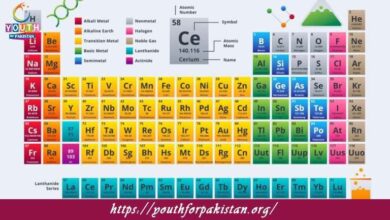12th Class Physics Chapter 20 MCQs with Answers

Master Atomic Spectra with 12th Class Physics Chapter 20 MCQs. Study energy levels, emission spectra, and Bohr’s model. Keywords like atomic spectra quiz, Bohr model MCQs, and spectroscopy test ensure excellent preparation.
The study of the emission and absorption of light by atoms is called:
a) Quantum Mechanics
b) Atomic Spectra
c) General Relativity
d) Thermodynamics
The lines in an atomic emission spectrum are due to:
a) Absorption of light by atoms
b) Reflection of light by atoms
c) Emission of light by atoms
d) Scattering of light by atoms
Which scientist proposed the Bohr model of the atom, which successfully explained the atomic spectra of hydrogen?
a) Max Planck
b) Niels Bohr
c) Werner Heisenberg
d) Albert Einstein
The discrete lines in an atomic emission spectrum are a result of:
a) The quantized energy levels of electrons in the atom
b) The continuous distribution of energy levels of electrons in the atom
c) The random motion of electrons in the atom
d) The scattering of light by electrons in the atom
The atomic spectra of different elements are used for:
a) Generating electricity
b) Identifying elements
c) Producing X-rays
d) Cooling down atoms
In the Bohr model of the hydrogen atom, electrons are arranged in:
a) Circular orbits around the nucleus
b) Random paths around the nucleus
c) Spherical shells around the nucleus
d) Elliptical orbits around the nucleus
The lines in an atomic absorption spectrum are due to:
a) Absorption of light by atoms
b) Emission of light by atoms
c) Scattering of light by atoms
d) Reflection of light by atoms
The energy of a photon emitted or absorbed during a transition between energy levels in an atom is given by:
a) Planck’s constant
b) The speed of light
c) The energy difference between the levels
d) The mass of the atom
The Balmer series in the hydrogen spectrum corresponds to transitions of electrons to the:
a) n = 1 energy level
b) n = 2 energy level
c) n = 3 energy level
d) n = 4 energy level
The Lyman series in the hydrogen spectrum corresponds to transitions of electrons to the:
a) n = 1 energy level
b) n = 2 energy level
c) n = 3 energy level
d) n = 4 energy level
The Paschen series in the hydrogen spectrum corresponds to transitions of electrons to the:
a) n = 1 energy level
b) n = 2 energy level
c) n = 3 energy level
d) n = 4 energy level
The energy of an electron in the Bohr model is quantized and given by the equation:
a) E = mv^2
b) E = mc^2
c) E = nhν
d) E = -13.6/n^2 eV
The energy levels of electrons in the Bohr model are labeled by the principal quantum number, denoted by:
a) n
b) m
c) l
d) s
The angular momentum of an electron in the Bohr model is quantized and given by the equation:
a) L = mv
b) L = nh/2π
c) L = mvr
d) L = mvr/2
The atomic spectra of elements show a pattern of lines because:
a) Electrons move in random paths around the nucleus
b) Electrons move in continuous orbits around the nucleus
c) Electrons can only exist in certain discrete energy levels
d) Electrons can have any energy level in the atom
The emission of light by excited atoms occurs when electrons:
a) Absorb photons and jump to higher energy levels
b) Absorb photons and return to lower energy levels
c) Emit photons and jump to higher energy levels
d) Emit photons and return to lower energy levels
The absorption of light by atoms occurs when electrons:
a) Absorb photons and jump to higher energy levels
b) Absorb photons and return to lower energy levels
c) Emit photons and jump to higher energy levels
d) Emit photons and return to lower energy levels
The energy difference between two energy levels in an atom is given by:
a) Planck’s constant
b) The speed of light
c) The energy of the emitted photon
d) The frequency of the emitted photon
The energy of a photon is directly proportional to its:
a) Frequency
b) Wavelength
c) Speed
d) Mass
The energy levels of an electron in an atom are quantized, meaning that they can only take on specific discrete values due to:
a) The wave nature of electrons
b) The particle nature of electrons
c) The electromagnetic nature of electrons
d) The quantization of angular momentum
Which of the following statements is true about the Bohr model of the atom?
a) It successfully explains the spectra of all elements.
b) It describes electrons as particles with definite positions and velocities.
c) It incorporates the wave nature of electrons.
d) It violates the principles of quantum mechanics.
The Balmer series in the hydrogen spectrum corresponds to transitions of electrons to the:
a) n = 1 energy level
b) n = 2 energy level
c) n = 3 energy level
d) n = 4 energy level
The Lyman series in the hydrogen spectrum corresponds to transitions of electrons to the:
a) n = 1 energy level
b) n = 2 energy level
c) n = 3 energy level
d) n = 4 energy level
The Paschen series in the hydrogen spectrum corresponds to transitions of electrons to the:
a) n = 1 energy level
b) n = 2 energy level
c) n = 3 energy level
d) n = 4 energy level
The energy of an electron in the Bohr model is quantized and given by the equation:
a) E = mv^2
b) E = mc^2
c) E = nhν
d) E = -13.6/n^2 eV
The energy levels of electrons in the Bohr model are labeled by the principal quantum number, denoted by:
a) n
b) m
c) l
d) s
The angular momentum of an electron in the Bohr model is quantized and given by the equation:
a) L = mv
b) L = nh/2π
c) L = mvr
d) L = mvr/2
The atomic spectra of elements show a pattern of lines because:
a) Electrons move in random paths around the nucleus
b) Electrons move in continuous orbits around the nucleus
c) Electrons can only exist in certain discrete energy levels
d) Electrons can have any energy level in the atom
The emission of light by excited atoms occurs when electrons:
a) Absorb photons and jump to higher energy levels
b) Absorb photons and return to lower energy levels
c) Emit photons and jump to higher energy levels
d) Emit photons and return to lower energy levels
The absorption of light by atoms occurs when electrons:
a) Absorb photons and jump to higher energy levels
b) Absorb photons and return to lower energy levels
c) Emit photons and jump to higher energy levels
d) Emit photons and return to lower energy levels
The energy difference between two energy levels in an atom is given by:
a) Planck’s constant
b) The speed of light
c) The energy of the emitted photon
d) The frequency of the emitted photon
The energy of a photon is directly proportional to its:
a) Frequency
b) Wavelength
c) Speed
d) Mass
The energy levels of an electron in an atom are quantized, meaning that they can only take on specific discrete values due to:
a) The wave nature of electrons
b) The particle nature of electrons
c) The electromagnetic nature of electrons
d) The quantization of angular momentum
Which of the following statements is true about the Bohr model of the atom?
a) It successfully explains the spectra of all elements.
b) It describes electrons as particles with definite positions and velocities.
c) It incorporates the wave nature of electrons.
d) It violates the principles of quantum mechanics.
The Balmer series in the hydrogen spectrum corresponds to transitions of electrons to the:
a) n = 1 energy level
b) n = 2 energy level
c) n = 3 energy level
d) n = 4 energy level
The Lyman series in the hydrogen spectrum corresponds to transitions of electrons to the:
a) n = 1 energy level
b) n = 2 energy level
c) n = 3 energy level
d) n = 4 energy level
The Paschen series in the hydrogen spectrum corresponds to transitions of electrons to the:
a) n = 1 energy level
b) n = 2 energy level
c) n = 3 energy level
d) n = 4 energy level
The energy of an electron in the Bohr model is quantized and given by the equation:
a) E = mv^2
b) E = mc^2
c) E = nhν
d) E = -13.6/n^2 eV
The energy levels of electrons in the Bohr model are labeled by the principal quantum number, denoted by:
a) n
b) m
c) l
d) s
The angular momentum of an electron in the Bohr model is quantized and given by the equation:
a) L = mv
b) L = nh/2π
c) L = mvr
d) L = mvr/2
The atomic spectra of elements show a pattern of lines because:
a) Electrons move in random paths around the nucleus
b) Electrons move in continuous orbits around the nucleus
c) Electrons can only exist in certain discrete energy levels
d) Electrons can have any energy level in the atom
The emission of light by excited atoms occurs when electrons:
a) Absorb photons and jump to higher energy levels
b) Absorb photons and return to lower energy levels
c) Emit photons and jump to higher energy levels
d) Emit photons and return to lower energy levels
The absorption of light by atoms occurs when electrons:
a) Absorb photons and jump to higher energy levels
b) Absorb photons and return to lower energy levels
c) Emit photons and jump to higher energy levels
d) Emit photons and return to lower energy levels
The energy difference between two energy levels in an atom is given by:
a) Planck’s constant
b) The speed of light
c) The energy of the emitted photon
d) The frequency of the emitted photon
The energy of a photon is directly proportional to its:
a) Frequency
b) Wavelength
c) Speed
d) Mass
The energy levels of an electron in an atom are quantized, meaning that they can only take on specific discrete values due to:
a) The wave nature of electrons
b) The particle nature of electrons
c) The electromagnetic nature of electrons
d) The quantization of angular momentum
Which of the following statements is true about the Bohr model of the atom?
a) It successfully explains the spectra of all elements.
b) It describes electrons as particles with definite positions and velocities.
c) It incorporates the wave nature of electrons.
d) It violates the principles of quantum mechanics.
The Balmer series in the hydrogen spectrum corresponds to transitions of electrons to the:
a) n = 1 energy level
b) n = 2 energy level
c) n = 3 energy level
d) n = 4 energy level
The Lyman series in the hydrogen spectrum corresponds to transitions of electrons to the:
a) n = 1 energy level
b) n = 2 energy level
c) n = 3 energy level
d) n = 4 energy level
The Paschen series in the hydrogen spectrum corresponds to transitions of electrons to the:
a) n = 1 energy level
b) n = 2 energy level
c) n = 3 energy level
d) n = 4 energy level
The energy of an electron in the Bohr model is quantized and given by the equation:
a) E = mv^2
b) E = mc^2
c) E = nhν
d) E = -13.6/n^2 eV
The energy levels of electrons in the Bohr model are labeled by the principal quantum number, denoted by:
a) n
b) m
c) l
d) s
The angular momentum of an electron in the Bohr model is quantized and given by the equation:
a) L = mv
b) L = nh/2π
c) L = mvr
d) L = mvr/2
The atomic spectra of elements show a pattern of lines because:
a) Electrons move in random paths around the nucleus
b) Electrons move in continuous orbits around the nucleus
c) Electrons can only exist in certain discrete energy levels
d) Electrons can have any energy level in the atom
The emission of light by excited atoms occurs when electrons:
a) Absorb photons and jump to higher energy levels
b) Absorb photons and return to lower energy levels
c) Emit photons and jump to higher energy levels
d) Emit photons and return to lower energy levels
The absorption of light by atoms occurs when electrons:
a) Absorb photons and jump to higher energy levels
b) Absorb photons and return to lower energy levels
c) Emit photons and jump to higher energy levels
d) Emit photons and return to lower energy levels
The energy difference between two energy levels in an atom is given by:
a) Planck’s constant
b) The speed of light
c) The energy of the emitted photon
d) The frequency of the emitted photon
The energy of a photon is directly proportional to its:
a) Frequency
b) Wavelength
c) Speed
d) Mass
The energy levels of an electron in an atom are quantized, meaning that they can only take on specific discrete values due to:
a) The wave nature of electrons
b) The particle nature of electrons
c) The electromagnetic nature of electrons
d) The quantization of angular momentum
Which of the following statements is true about the Bohr model of the atom?
a) It successfully explains the spectra of all elements.
b) It describes electrons as particles with definite positions and velocities.
c) It incorporates the wave nature of electrons.
d) It violates the principles of quantum mechanics.
If you are interested to enhance your knowledge regarding Physics, Chemistry, Biology, and Computer please click on the link of each category, you will be redirected to dedicated website for each category.





